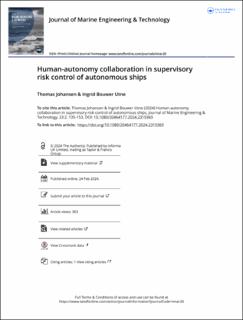| dc.contributor.author | Johansen, Thomas | |
| dc.contributor.author | Utne, Ingrid Bouwer | |
| dc.date.accessioned | 2024-04-08T11:12:23Z | |
| dc.date.available | 2024-04-08T11:12:23Z | |
| dc.date.created | 2024-04-01T12:40:55Z | |
| dc.date.issued | 2024 | |
| dc.identifier.citation | Journal of Marine Engineering & Technology. 2024, 23 (2), 135-153. | en_US |
| dc.identifier.issn | 2046-4177 | |
| dc.identifier.uri | https://hdl.handle.net/11250/3125264 | |
| dc.description.abstract | This paper presents a method for developing and testing a risk-based control system, as a first step towards including the human supervisor explicitly in the design of the system. The result is a control system with improved decision-making capabilities compared to existing control systems. The methodology presented in the paper uses the Systems Theoretic Process Analysis (STPA) to analyse the risks of an autonomous ship within its concept of operations (CONOPS), and a Human-STPA (H-STPA) is used to analyse human responsibilities and involvement. The STPA results are then used to construct a Bayesian belief network (BBN)-based risk model to assess the operational risk of the ship. This is represented as a risk cost, describing the expected cost of consequences caused by potential hazardous events. This cost is combined with fuel costs, operations costs, and the potential loss of income if new missions are not undertaken using a supervisory risk controller (SRC). The SRC is capable of making decisions about how the ship should be safely operated and notifies the human supervisor in due time when it is necessary for them to take control. The last part of the methodology presented in this paper is testing the control system using a set of verification objectives based on results from the STPA and H-STPA. A case study involving an autonomous cargo ship with a human supervisor located in a remote operation center (ROC) is included; it shows that the proposed control system can operate the ship safely in different conditions and situations. By designing the SRC to notify the human supervisor before it reaches its operational limit, the ship is able to operate in a wider range of conditions compared to when just the autonomous control system is in charge. Hence, the proposed methodology shows promising results and provides useful insights related to shared control for autonomous ships. | en_US |
| dc.language.iso | eng | en_US |
| dc.publisher | Taylor & Francis | en_US |
| dc.rights | Navngivelse 4.0 Internasjonal | * |
| dc.rights.uri | http://creativecommons.org/licenses/by/4.0/deed.no | * |
| dc.title | Human-autonomy collaboration in supervisory risk control of autonomous ships | en_US |
| dc.title.alternative | Human-autonomy collaboration in supervisory risk control of autonomous ships | en_US |
| dc.type | Journal article | en_US |
| dc.type | Peer reviewed | en_US |
| dc.description.version | acceptedVersion | en_US |
| dc.source.pagenumber | 135-153 | en_US |
| dc.source.volume | 23 | en_US |
| dc.source.journal | Journal of Marine Engineering & Technology | en_US |
| dc.source.issue | 2 | en_US |
| dc.identifier.doi | 10.1080/20464177.2024.2319369 | |
| dc.identifier.cristin | 2257760 | |
| cristin.ispublished | true | |
| cristin.fulltext | postprint | |
| cristin.qualitycode | 1 | |

